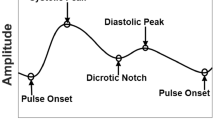Abstract
Traditional premature ventricular contraction (PVC) detection algorithms based on template matching use fixed templates which is sensitive to the variability of electrocardiogram (ECG) and is likely to reduce detection accuracy. This paper proposes an effective PVC detection algorithm based on adaptive template matching and characteristic recognition. An adaptive template update rule has been developed to construct the optimal normal heartbeat template library, which is used to identify normal and abnormal beats. And the matching result directed the subsequent characteristic classification. Four features were extracted and used for PVC recognition based on feature knowledge. The algorithm is evaluated on the MIT-BIH arrhythmia dataset, and the results show that the accuracy was 99.48%, and the sensitivity and specificity were 98.39% and 99.54%, respectively. And it is compared with those of other recent approaches algorithms, which shows higher sensitive and accurate, and its low complexity is suitable for real-time ECG monitoring in wearable ECG devices.




Similar content being viewed by others
Data availability
The data used to support the findings of this study have been deposited in the MIT-BIH arrhythmia database (https://doi.org/https://doi.org/10.13026/C2F305).
References
Abdalla, F.Y.O., Wu, L., Ullah, H., et al.: ECG arrhythmia classification using artificial intelligence and nonlinear and nonstationary decomposition. SIViP 13, 1283–1291 (2019)
Lin, M.: Design of premature ventricular contraction pacing point localization algorithm for dynamic electrocardiogram. Southeast University (2018)
Wang, J.: Automated detection of premature ventricular contraction based on the improved gated recurrent unit network. Comput. Methods Progr. Biomed. 208, 106284 (2021)
Du, Q., Zhang, W.: Research on arrhythmia detection model based on machine learning. Journal of Liaoning University of Science and Technology (2020)
Yang, B., Zhang, Y.: Ventricular premature beat discrimination algorithm based on multiple template matching. Comput. Eng. 36(16), 291–296 (2010)
Hu, S., Gao, R., Liu, L., et al.: Summary of China cardiovascular disease report 2018. Chin. Circ. J. 34(3), 209–220 (2019)
Yan, H., An, Y., Wang, H., et al.: ECG feature extraction based on convolutional neural network. Comput. Eng. Des. 38(4), 1024–1028 (2017)
Wang, T.: Research on ventricular premature beat detection based on rule mechanism and machine learning. Southeast University (2021)
Wu, Y., Xu, Y.: A ventricular premature beat detection algorithm based on improved deep convolutional neural network. Comput. Appl. Softw. 11 (2019)
Ojha, M.K., Wadhwani, S., Wadhwani, A.K., Shukla, A.: Automatic detection of arrhythmias from an ECG signal using an auto-encoder and SVM classifier. Phys. Eng. Sci. Med. 45(2), 665–674 (2022)
Chen, Y., Zhang, C., Liu, C., et al.: Atrial fibrillation detection using a feedforward neural network. J. Med. Biol. Eng. 42, 63–73 (2022)
Lim, J.S.: Minimum fuzzy membership function extraction for automatic premature ventricular contraction detection. J. Internet Comput. Serv. 8(1), 125–132 (2007)
Atanasoski, V., Ivanovic, M.D., Marinkovic, M., et al.: Unsupervised classification of premature ventricular contractions based on RR interval and heartbeat morphology]. In: 2018 14th symposium on neural networks and applications (NEUREL). IEEE 1–6 (2018)
Malek, A.S., Elnahrawy, A., Anwar, H., et al.: Automated detection of premature ventricular contraction in ECG signals using enhanced template matching algorithm. Biomed. Phys. Eng. Exp. 6(1), 1–12 (2020)
Krasteva, V., Jekova, I.: QRS template matching for recognition of ventricular ectopic beats. Ann. Biomed. Eng. 35(12), 2065–2076 (2007)
Oliveira, B.R.D.: Geometrical features for premature ventricular contraction recognition with analytic hierarchy process-based machine learning algorithms selection. Comput. Methods Progr. Biomed. 169, 59–69 (2019)
Zarei, R., He, J.: Effective and efficient detection of premature ventricular contractions based on variation of principal directions. Digital Signal Process. 50(4), 93–102 (2016)
Allami, R.: Premature ventricular contraction analysis for real-time patient monitoring. Biomed. Signal Process. Control 47(2), 358–365 (2019)
Samsudin, N.N., Isaak, S., Paraman, N.: Implementation of optimized low pass filter for ECG filtering using verilog. J. Phys. Conf. Ser. 2312(1), 12–49 (2022)
Talbi, M.L., Ravier, P.: Detection of PVC in ECG signals using fractional linear prediction. Biomed. Signal Process. Control 23(2), 42–51 (2016)
Pan, J., Tompkins, W.J.: A real-time QRS detection algorithm. IEEE Trans. Biomed. Eng. 32, 230–236 (1985)
Talbi, M.L., Charef, A.: PVC discrimination using the QRS power spectrum and self-organizing maps. Comput. Methods Progr. Biomed. 94(3), 223–231 (2009)
Dutta, S., Chatterjee, A., Munshi, S.: Correlation technique and least square support vector machine combine for frequency domain based ECG beat classification. Med. Eng. Phys. 32(10), 1161–1169 (2010)
Li, P., Liu, C., Wang, X., et al.: A low-complexity data-adaptive approach for premature ventricular contraction recognition. SIViP 8(1), 111–120 (2013)
Acknowledgements
This work was supported by the Wuhan Knowledge Innovation Project (No. 2022020801010258).
Author information
Authors and Affiliations
Contributions
Xiangkui wan presented the conception and design of the study and interpretation of data. Yunfan Chen drafted the article and revised it critically for important intellectual content. Jiale Xu and Xiaoyu Mei wrote the main manuscript text and prepared figures. All authors reviewed the manuscript and final approval of the version to be submitted.
Corresponding author
Ethics declarations
Conflict of interest
The authors declare that they have no conflicts of interest.
Additional information
Publisher's Note
Springer Nature remains neutral with regard to jurisdictional claims in published maps and institutional affiliations.
Rights and permissions
Springer Nature or its licensor (e.g. a society or other partner) holds exclusive rights to this article under a publishing agreement with the author(s) or other rightsholder(s); author self-archiving of the accepted manuscript version of this article is solely governed by the terms of such publishing agreement and applicable law.
About this article
Cite this article
Xu, J., Mei, X., Chen, Y. et al. An effective premature ventricular contraction detection algorithm based on adaptive template matching and characteristic recognition. SIViP 18, 2811–2818 (2024). https://doi.org/10.1007/s11760-023-02951-y
Received:
Revised:
Accepted:
Published:
Issue Date:
DOI: https://doi.org/10.1007/s11760-023-02951-y




